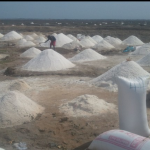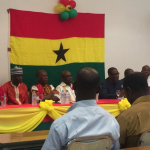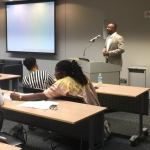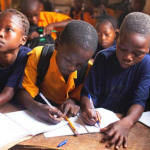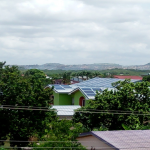ASHANTEMAN CRAFTWORK

Looking at it from the Ghana map. It’s one of the smallest regions in the country. On the other hand, it is one of the most populated regions. This region is highly recognized for the production of gold and cocoa. With Kumasi being its capital region, the Ashanti region is actually one of the most popular in the country located centrally in the middle belt of Ghana. It’s indigenes have always been known as loyal people who will fight together to achieve a particular aim. The unity of these group of people made them get recognized by the British, Ghana’s colonial masters. One symbolic thing is their golden stool.
It is believed that stool was commanded from the heavens by their very renowned fetish priest known as Okomfo Anokye. It’s believed that when the golden stool gets missing the entire kingdom would fall apart. This man during those days did a lot of miraculous things including; planting a plantain tree which germinated and grew to cultivation that same day, and the irremovable sword he put into the ground among a lot more. They treat their territory as a kingdom and they are headed by a king known as the “Ashanti Hene”. Most of the people are either into trading of food stuffs, car parts or farming.
The region has a lot of places for sight-seeing. For reserves and parks we have the; Kogyae Strict Nature Reserve, Bobiri Forest and Butterfly Sanctuary, Digya National Park and Kogyae Strict Nature Reserve. The recreation areas include; Rattray Park and Centre for National Culture. Historic sites include; Komfo Anokye Sword, Armed Forces Museum, the Ashante Traditional Buildings and Manhyia Palace Museum. The region has the Kwame Nkrumah University of Science and Technology, one of the oldest and most prestigious universities in the country which does a lot of science related programme.
The first town to have started producing this kind of fabric is the people of Bonwire. Kente portrays the rich culture of the land. The colours, symbols and how it is woven all symbolizes something. It is woven using local technology. Kente is very expensive and depending on how beautiful it is, the price increases. It’s considered a royal cloth and so a lot of the chiefs patronize it. Even now at traditional weddings, the couple wear kente.
There’s also the Adinkra cloth. It is also known as tye and dye. It made with cotton fabric, stamped and dyed. Most of the stamping is done using stamps which have the Adinkra symbols on them, these symbols symbolize a lot of things. Some of these symbols like; akoma, sankofa, nyamebiibi wosoro, gye nyame and akofena have various meanings which all portray the Ghanaian culture.
Another craft of the people of the Ashanti Kingdom is the fertility Akuaba Doll. This is a locally carved piece of wood which looks like a human face with arms stretched. It is believed that when pregnant women wear this around their neck, they give birth to very beautiful children.
Interesting right?….. it would amaze you to know that a lot of the times the pregnant women who wear this actually end up having very beautiful children. Whether the dolls has that effect or not…..its not proven.
When you are looking for place recognized for great pottery, look no further than the Ashanti region. The region is known as one of the places for skillful indeginous potters in the country. Through the use of locally coined technology, these potters who consists of both men and women do a great job. These pots and others like the earthenware bowl are bought by foreigners and other local people for use as well as to serve a memory that they have been to Ghana.
They even make some ceramic wares as well. I must say some of them are very nice. A lot of the local folk even though may have fridges still prefer the pot as a storage for drinking water because they say it keeps the water cool even in lights out and gives it a pleasant after taste which makes one feel at home.
Wood carving is done almost everywhere in Ghana. During my childhood I was always cared of these wood carvings but there are people who are very much lovers of wood carvings. These are often used as decoration pieces in the houses, offices and hotels. The wood carving tradition was always an important part of the culture of ethnic Akan.
There are so many wood carvers in the region who make beautiful carvings. Some of these things sell at very high prices. Most of the tourists buy and take it to their countries and make huge sums of money from it. The carved wood items include; drums, masks, fertility dolls, mortars and stools.
One other craft work which is making waves in the country is beading. The Ashanti Region is one of the regions pioneering the move. When Africans are dressing, one thing you are likely to notice is the presence of colourful beads. These beads are made from either glass, stones and other materials. Formally beads were used as accessories worn with traditional garments but now even corporate dressing is made complete with a touch of African beads.
Bead making has become one business that people have become very interested in. A lot of the graduates who are not employed have business ventures in bead making. Bead making has become very popular with different ideas being put into it to make it more classic. Beading has been included even I sewing such that after dresses are sewn, beading is done to make it more beautiful. A lot of kente fabrics used for the females during their traditional engagement are usually beaded. Now there are beaded bags, slippers, phone cases, key holders among others.
Crafts bring out a lot of culture, arts and tradition. The Ashanti land has a lot more to do with the lot of the crafts than we are seeing. To make these crafts popular we must patronize them ourselves and make them more attractive to the foreigners. When the foreigners get to send our products out, they eventually would market it to the others and make it popular. This would eventually bring more people who are interested in arts work and craft into the country, create employment opportunies and help in nation building.


